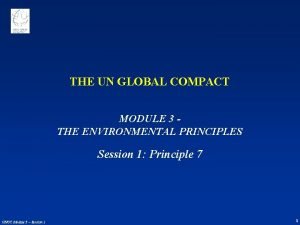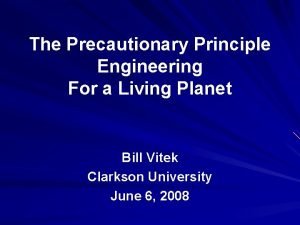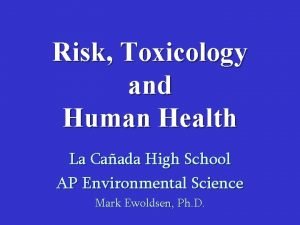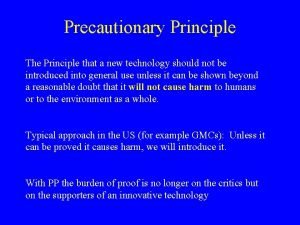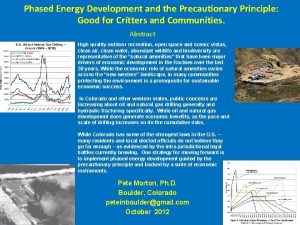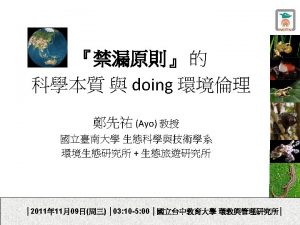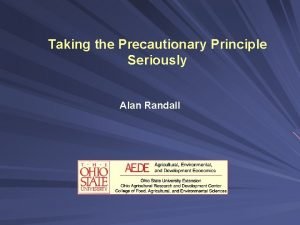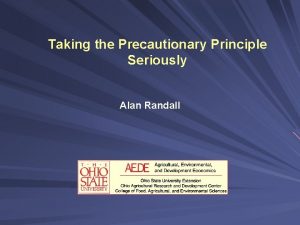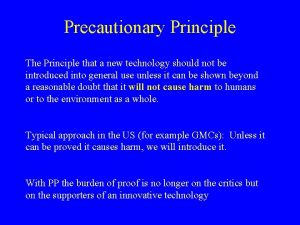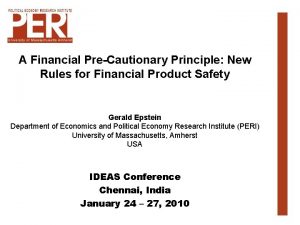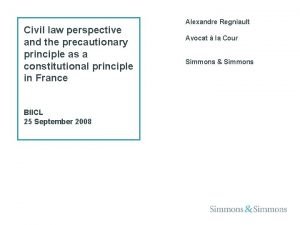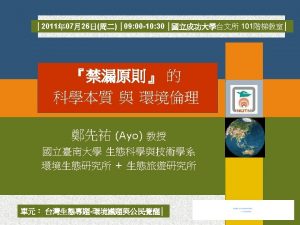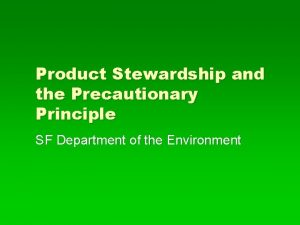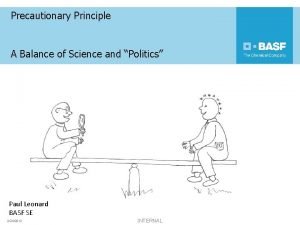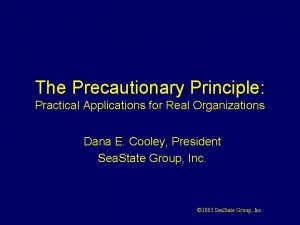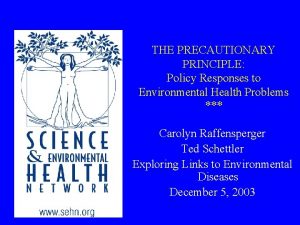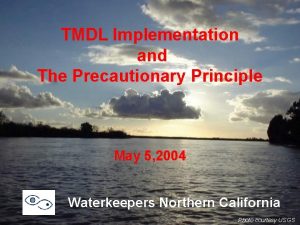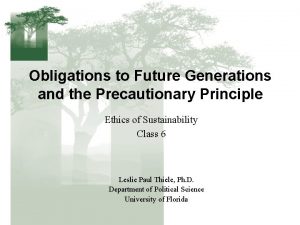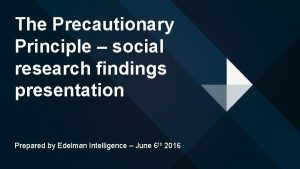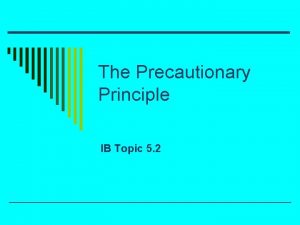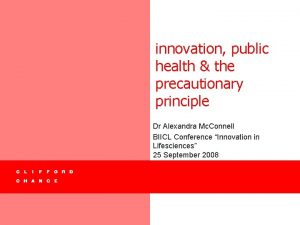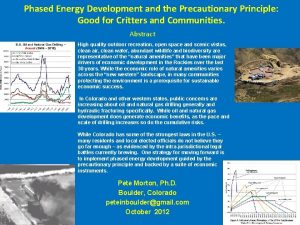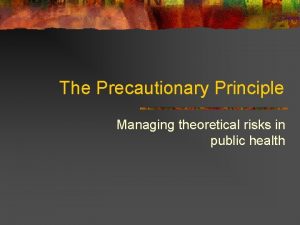Precautionary Principle The Principle that a new technology

































- Slides: 33

Precautionary Principle The Principle that a new technology should not be introduced into general use unless it can be shown beyond a reasonable doubt that it will not cause harm to humans or to the environment as a whole. Typical approach in the US (for example GMCs): Unless it can be proved it causes harm, we will introduce it. With PP the burden of proof is no longer on the critics but on the supporters of an innovative technology

What is the precautionary principle? • The “BETTER SAFE THAN SORRY” approach. • Used by decision-makers to manage risk. • Judging what constitutes an “acceptable” level of risk for society is a political responsibility. • PP in at least 12 international environmental treaties -- and enacted into law by several European countries.

Nature of the Issue • The economy modern scientific societies depends on innovation • A consequence of innovation is the contamination of the environment • Scientific innovation both benefits and harms us

Precautionary Principle (PP) • As a concept, the Precautionary Principle (PP) would prevent the introduction of new technology even if only the possibility that there is a threat to the environment or to human health--even without hard, scientific evidence for that threat to exist.

Nature of the Issue • Some say that the most likely the problems caused by science are solved only by science. • Should we be skeptical of this idea?

Questions • Should scientific innovation be held to closer scrutiny? • Should projects such as gene modified foods, cloning, irradiation of food or nanotechnology require state or national or approval before commencing? • Have we enter an age in which unbridled entrepreneurship is no longer possible?

PP doesn’t make decisions The precautionary principle is not an algorithm for making decisions. It is a principle used in taking decisions. It is like the legal principle that the burden of proof in a criminal trial is on the prosecution. Both introduce a deliberate bias into decision making. “It is better than 100 guilty men go free than that one innocent man is convicted. ” The jury still has to decide when a case is proven beyond reasonable doubt – and also what they consider to be “reasonable doubt”.

PP Opposition • • • PP is opposed by some scientists and many business people due to fear that progress would slow down bureaucrats would chose projects economies would go into recession funding for innovation would dry up elimination of such disease as cancer, m. d. , heart, diabetes would occur more slowly if at all New viruses similar to SARS and ebola would rage unchecked to pandemic levels

PP Supporters • PP promises a safer, cleaner environment • PP promises that decisions about our environment would be made by citizens rather than corporations

Precautionary Principle The Key Word is Precaution

Precautionary Principle • Decision makers should act in advance of scientific certainty to protect the environment from incurring harm.

Precautionary Principle: Wingspread Statement • The release and use of toxic substances, the exploitation of resources, and physical alterations of the environment have had substantial unintended consequences affecting human health and environment.

Guideline to Activate PP It should be neither so weak as to be vacuous, nor so strong that it would halt progress It is not an alternative to legal proceedings; it should be a part of them.

Cost and Benefit Analysis It may impose a cost, but the cost of putting things right afterwards can be orders of magnitude greater.

COST of Applying PP • The cost is often overestimated because alternatives may exist or can be developed if resources are allocated for the purpose

Invoking the Precautionary Principle Requires Three Conditions to be Met: 1. Sufficient scientific information to raise the possibility of adverse impacts on humans or the environment. 2. Uncertainty as to the extent of the effects, with a possible worst case scenario of highly significant harm. 3. The action advocated under the precautionary principle must have significant economic of societal costs.

The extent that a society lives by the precautionary principle can best be measured by the extent to which precautionary actions turn out to have been unnecessary.

Some current Potentially Harmful Examples • GM crops • Nuclear energy • Food Irradiation • Climate change – will it be abrupt? • Nanotechnology

Example: Asbestos First mined in Canada in 1879 In 1898, Lucy Deane, one of the first Women Inspectors of Factories, included asbestos work as one of the four dusty occupations to come under observation that year “on account of their easily demonstrated danger to the health of workers and because of ascertained cases of injury to bronchial tubes and lungs medically attributed to the employment of the sufferer. ”

1917: UK Factory Department finds insufficient evidence to justify action. 1918: US and Canadian insurance companies decline insurance cover for asbestos workers “due to the assumed injurious conditions in the industry. ” 1930: UK report finds 66% of long term workers in Rochdale factory with asbestosis. In 1931 regulations specify dust control in manufacturing 1960: Mesothelioma cancer in workers and public identified in South Africa 1962/4: Also identified in workers, relatives and “bystanders” in many countries

1969: UK regulations improve controls but ignore users 1982 -9: tightening of controls in UK on producers and users and moves to find substitutes 1998 -9: UK and France ban all forms of asbestos 2000 -1: WTO rejects Canada’s appeal against this ban 2003 - : It is estimated that some 250, 000 more people in the EU will die of mesothelioma or asbestosis. (The time from first exposure to the onset of mesothelioma is about 40 years; for lung cancer 20 -25. )

Precautionary Principle Criticisms

Common criticisms of PP Anti-scientific – mostly about unscientific prejudice Vacuous: Does not lead to definite decisions Too weak – contributes nothing that is not already there, eg in risk assessment Too strong – will stop progress dead in its tracks Merely a cover for protectionism The issues are better dealt with in the courts

Precautionary Principle Criticism • • Refuge from the need to understand science Simplistic shortcut to regulatory action Policy high ground (feel good approach) Avoidance of trade off decisions

Example of a Public Health Loss Ascribable to the Precautionary Principle: Zambia • Widespread hunger due to food shortages in Zambia in 2002 • Cornmeal is base of standard Zambian diet • 75% of food supplied to Zambia by UN World Food Program (WFP) donated by US • Corn sent by US is routinely part of US diet

Example of a Public Health Loss Ascribable to the Precautionary Principle: Zambia • Zambia has ruled that GMO corn is not safe and will not distribute it. Zambia is also concerned about losing any future export market to EU. • In August 2002, 14, 000 metric tons of US grain in storehouses and much more on way, but only 7000 tons of food, approx. 2 weeks worth, available for distribution to 2. 5 million people in need

Example of a Public Health Loss Ascribable to the Precautionary Principle: Zambia • Zambian President Levy Mwanawasa said “I’m not prepared to accept that we should use our people as guinea pigs”. • Asked if he believes US grain is poisonous, Zambian Agriculture Minister Sikatana stated: “What else would you call an allergy caused by a substance? That substance that the person reacts to is poisonous” • “Many Zambians … wonder why friends who received the American corn before the ban went into effect have not died” » Henri Cauvin, NY Times, 8/30/02; 9/4/02

Some problems with the PP • It implies a quest for certainty in knowledge. • Seeks to transfer decision-making processes back to state agencies in the name of public safety rather than the marketplace. • Fails to account for when exposures create benefits as well as risks (e. g. red wine).

Definition of the Precautionary Principle (Cynical American Version) The Precautionary Principle is a nebulous doctrine developed by Europeans as a means to erect a trade barrier against any item that can be produced more efficiently in the United States.

Rio Declaration 1992 In order to protect the environment, the precautionary approach shall be widely applied by States according to their capabilities. Where there are threats of serious or reversible damage, lack of full scientific certainty shall not be used as a reason for postponing cost-effective measures to prevent environmental degradation.

Precautionary Principle • Is Scientific uncertainty: the heart of precaution? • Is Precaution… an issue of ethics, morality, and truth? • Is PP about protecting future generations who have no power over the decisions made today, and protecting those who are most vulnerable or with the least power in a society?

Precautionary Principle • Existing environmental regulations particularly those based on risk assessment, have failed to protect adequately human health and the environment – the larger system of which humans are but a part.

• PP Plays a strong role in debates about nuclear power, wireless communications devices, greenhouse gases and G. M. O’s.
 Precautionary principle
Precautionary principle Precautionary principle
Precautionary principle Precautionary principle
Precautionary principle Biological hazard
Biological hazard Precautionary principle in environmental law
Precautionary principle in environmental law Precautionary principle
Precautionary principle Precautionary principle
Precautionary principle Sds stands for whmis
Sds stands for whmis Ngoại tâm thu thất chùm đôi
Ngoại tâm thu thất chùm đôi Block nhĩ thất độ 2 type 1
Block nhĩ thất độ 2 type 1 Thơ thất ngôn tứ tuyệt đường luật
Thơ thất ngôn tứ tuyệt đường luật Thơ thất ngôn tứ tuyệt đường luật
Thơ thất ngôn tứ tuyệt đường luật Walmart thất bại ở nhật
Walmart thất bại ở nhật Tìm vết của đường thẳng
Tìm vết của đường thẳng Con hãy đưa tay khi thấy người vấp ngã
Con hãy đưa tay khi thấy người vấp ngã Tôn thất thuyết là ai
Tôn thất thuyết là ai Gây tê cơ vuông thắt lưng
Gây tê cơ vuông thắt lưng Sau thất bại ở hồ điển triệt
Sau thất bại ở hồ điển triệt Hình ảnh bộ gõ cơ thể búng tay
Hình ảnh bộ gõ cơ thể búng tay Lp html
Lp html Bổ thể
Bổ thể Tỉ lệ cơ thể trẻ em
Tỉ lệ cơ thể trẻ em Chó sói
Chó sói Tư thế worms-breton
Tư thế worms-breton Chúa sống lại
Chúa sống lại Môn thể thao bắt đầu bằng chữ f
Môn thể thao bắt đầu bằng chữ f Thế nào là hệ số cao nhất
Thế nào là hệ số cao nhất Các châu lục và đại dương trên thế giới
Các châu lục và đại dương trên thế giới Công thức tiính động năng
Công thức tiính động năng Trời xanh đây là của chúng ta thể thơ
Trời xanh đây là của chúng ta thể thơ Mật thư tọa độ 5x5
Mật thư tọa độ 5x5 Phép trừ bù
Phép trừ bù độ dài liên kết
độ dài liên kết Các châu lục và đại dương trên thế giới
Các châu lục và đại dương trên thế giới
